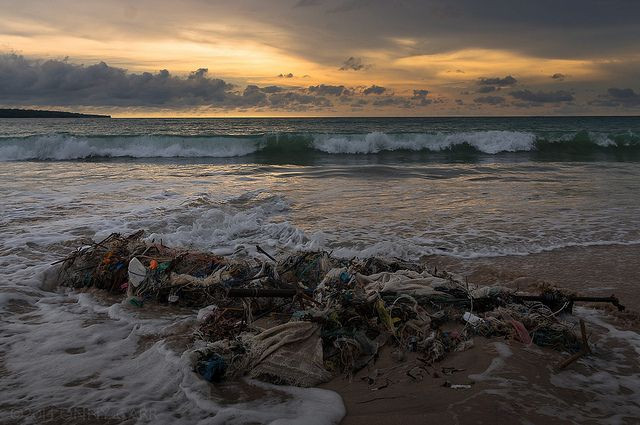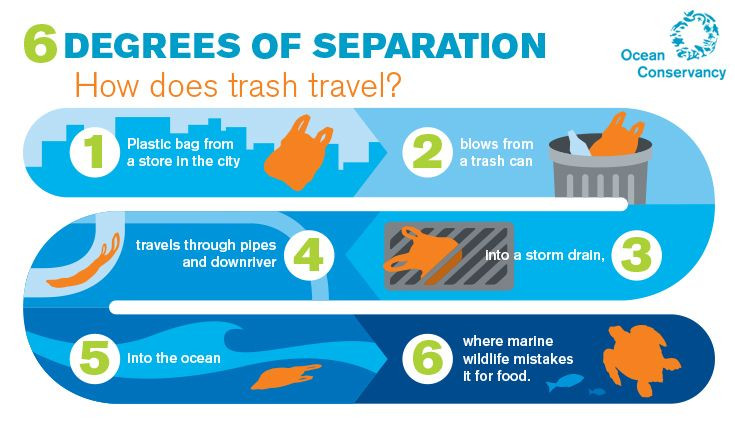Ocean Pollution: 5 Trillion Plastic Pieces Float On Surface, Harming Wildlife And Eventually Humans, Too

The Ocean Conservancy, during its annual 2013 International Coastal Cleanup, reported over 12.3 million pounds of trash down the coast of our beaches and waterways — enough to fill the United States Capital Rotunda two-and-a-half times. There were your usual suspects: cigarette butts, food wrappers, plastic bottles and caps, straws, stirrers, and grocery bags. But the coast only scrapes the surface of the global problem that is ocean pollution. According to a new study published in the journal PLOS One, there are more than five trillion plastic pieces afloat at sea.
This study is the first to estimate the total number of plastic particles (and their weight) floating in the world's oceans. Twenty-four expeditions were led from 2007 to 2013, including in all five sub-tropical currents, coastal Australia, the Bay of Bengal, and the Mediterranean Sea. Each expedition conducted surface net tows and completed visual surveys of large plastic debris. After using an oceanographic model to calibrate their data, researchers estimated there’s a minimum of 5.25 trillion particles weighing 268,940 tons floating in the ocean. Surprisingly, this number is less than they expected.
This, they added, is evidence of “removal processes at play.” You would think this means an increase in expeditions and cleanups, but that’s not entirely the case. If plastic particles aren’t biodegradable, they’re ingested by wildlife, breaking down into too-small particles for surface nets, or simply washing ashore. Researchers did stress their estimates are “highly conservative” and based on a limited inventory of ocean observations. To improve their “minimum estimates,” they would incorporate standardization of methods, and increased expeditions and surveys. These numbers are also limited to what is afloat, not what’s present on shorelines, on the sea bed, suspended in the water column, and within organisms.
“Ocean trash truly is a global problem that affects human health and safety, endangers marine wildlife, and costs states and nations countless millions in wasted resources and lost revenue,” Andreas Merkl, Ocean Conservancy’s president and CEO, said in a press release. “At its core, however, ocean trash is not an ocean problem; it is a people problem — perpetuated by the often unwitting practices that industry and people have adopted over time. But I am convinced we can solve it if we have the audacity to confront the problem head-on.”

Merkl also released a statement following the publishing of the present study, reiterating how imperative it is to work together and alleviate the ocean and the ocean's coast of their plastic and trash problem. The fact wildlife often ingests trash tucks into the Ocean Conservancy’s idea of the six degress of separation (pictured above). The trash we discard and think we’ll never see again, in fact, makes it way to sea and into these animals, like one of the Earth's oldest creatures sea turtles, but also the marine life we frequently consume such as fish. The high level of trash isn't only alarming for the sake of our eco-system; it's alarming for the sake of public health.
“There are toxicological signs that marine life ingests the chemicals and additives used in plastics, which means there’s a chance that passes on to the people who eat them,” Nicholas Mallos, conservation biologist and marine debris specialist, said.
The same "reduce, reuse, and recyle" mantra engrained in you during middle school still applies today. Reduce the chances of trash traveling by discarding it in a trash can with a lid, so there's less of a chance of it blowing away. Reuse coffee mugs and shopping bags, and of course, recycle plastic bottles and supplies as much as possible. Small steps will eventually add up for a big payoff, and the ocean's coast, marine life, and the people who frequent it will be trash-free.
Source: Eriksen M et al. Plastic Pollution in the World's Oceans: More than 5 Trillion Plastic Pieces Weighing over 250,000 Tons Afloat at Sea. PLOS One. 2014.
Published by Medicaldaily.com



























